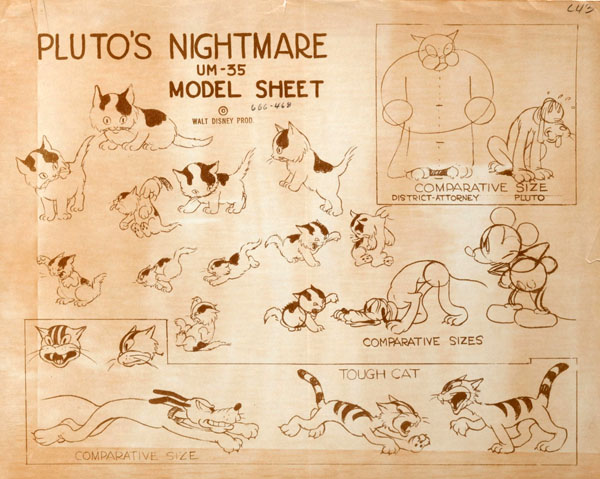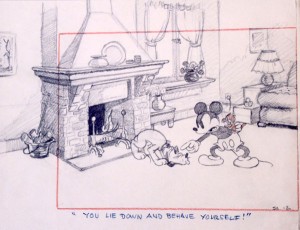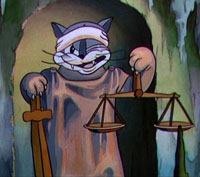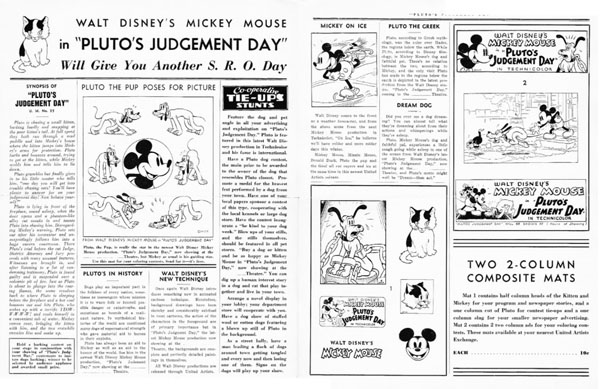Today, a little variety for this week, with our first Disney breakdown!
Just for the record, for some readers that have been wondering, I have no access to any drafts from Iwerks, Mintz/Screen Gems, Van Beuren, or any Warners drafts with Avery, Tashlin or Jones attached to them. I think the more prestigious members of the animation community would be shocked if such materials surfaced. If you are aware of such material – contributions to the cause are always welcome. Drafts for UPA’s cartoons do exist, but are unavailable to me at this time.

Pluto’s Judgement Day, though part of the Mickey Mouse series, is more of a vehicle for his canine pal. The Disney cartoons gravitated to a darker sensibility when the story called for it – a move that often proved successful. Director Dave Hand tended to handle somber material in his cartoons, such The Mad Doctor, Who Killed Cock Robin, and Three Little Wolves. Disney’s own “failed effort” The Golden Touch has a similarly apprehensive tone in its second half. Like Cock Robin, the body of Judgement Day takes place in a courtroom, and is set to rhyming and cadenced dialogue. Bill Cottrell and Joe Grant, the writers of Cock Robin, claimed to have written this cartoon, but no written evidence concurs this assertion.
The theme of the forthcoming danger that lingers with entering damnation wasn’t a foreign subject in animated cartoons, and was often depicted in a surrealistic or didactic approach. The early sound East Coast studios put characters through bizarre interludes for their wrongdoings, like Fleischers’ Swing You Sinners, and Van Beuren’s Gypped in Egypt and Panicky Pup. Cartoons released after Judgement Day put characters in the face of it under jurisprudence of their sins. Examples include Warners’ Sunday Go to Meetin’ Time, Heavenly Puss with MGM’s Tom and Jerry, and Famous Studios’ Noveltoon A Mutt in a Rut (which lifts elements from Judgement Day) and Mice-Capades with Herman and Katnip.

By the time this cartoon was in production, around 1935, Disney’s renowned gleam, in preparation for Snow White, suffused their product in sophisticated animation, backgrounds, color and special effects. The advancement was more most prevalent in the Silly Symphonies, but many of the homegrown artists and former New York animators – like Bill Tytla and Grim Natwick — were so neatly set in place that a drastic progression was the studio’s only option. Dave Hand casts the animators by sequence here. Fred Moore animates the opening scenes with Mickey and Pluto, Dick Lundy and Gerry Geronimi handle the lead-in to the courtroom cavern, Bill Roberts animates Pluto, the judge and district attorney during the trial, Bob Wickersham handles the jury, Ham Luske, along with Ward Kimball, animate the feline victims, and Hardie Gramatky animates the finale/ending.
 Dave Hand was a newspaper cartoonist before he moved to Chicago to attend commercial-art classes. Hand ran out of money, and soon began his career in animation, working on Wallace Carlson’s “Andy Gump” cartoons in New York. He later moved to Fleischer, claiming to have been a writer/director on the Out of the Inkwell series with Koko the Clown. Hand switched to the Bray Studio, animated and co-directing with Walter Lantz on the Dinky Doodle and Unnatural History series before the studio closed. He moved to Hollywood in hopes of a live-action career but was hired at Disney’s studio on his 30th birthday on January 23, 1930.
Dave Hand was a newspaper cartoonist before he moved to Chicago to attend commercial-art classes. Hand ran out of money, and soon began his career in animation, working on Wallace Carlson’s “Andy Gump” cartoons in New York. He later moved to Fleischer, claiming to have been a writer/director on the Out of the Inkwell series with Koko the Clown. Hand switched to the Bray Studio, animated and co-directing with Walter Lantz on the Dinky Doodle and Unnatural History series before the studio closed. He moved to Hollywood in hopes of a live-action career but was hired at Disney’s studio on his 30th birthday on January 23, 1930.
He became a director at the studio around 1932 with the Mickey Mouse short Building a Building, and often assembled a strong crew of animators based on their capabilities for his short cartoons, such as he did for Judgment Day. Disney entrusted him as a supervising director for Snow White and Bambi. By this time, Hand became a subordinate, supervising shorts production and maintaining the studio’s operations. By the early forties, many of Disney’s loyal artists were pushed out of the studio or relegated into different positions within the studio. This made Hand feel unwelcome, and he left the studio in July 1944. He spent several years in England establishing the Gaumont British animation studio for the J. Arthur Rank organization, creating the Animaland and Musical Paintbox series before its closure in 1950. Hand returned to the States and worked on commercial and industrial films at the Alexander Film Company in Colorado for the rest of his career.
 Fred Moore’s broad yet charming drawings broke away from the rubber-hose clichés of early sound animation and influenced the studio throughout the thirties. His first scene, of Pluto chasing the kitten, does an impressive task of depicting weight as he skids around the corner and continues to the left. There is also brilliant acting and posing in the neatly staged sequence of Mickey admonishing Pluto. Dick Lundy’s sequence of Pluto being instigated by a phantom bully cat, and brusquely ignoring a transparent Mickey’s plea, also hews to a high standard of staging and posing. Bill Roberts’ drawing/movement are exceptional and intricately detailed. He handles Pluto with “a bunched-up body and a big snout” – as Shamus Culhane described – but his animation of the district attorney really shines, with several horrifying and effective close-ups.
Fred Moore’s broad yet charming drawings broke away from the rubber-hose clichés of early sound animation and influenced the studio throughout the thirties. His first scene, of Pluto chasing the kitten, does an impressive task of depicting weight as he skids around the corner and continues to the left. There is also brilliant acting and posing in the neatly staged sequence of Mickey admonishing Pluto. Dick Lundy’s sequence of Pluto being instigated by a phantom bully cat, and brusquely ignoring a transparent Mickey’s plea, also hews to a high standard of staging and posing. Bill Roberts’ drawing/movement are exceptional and intricately detailed. He handles Pluto with “a bunched-up body and a big snout” – as Shamus Culhane described – but his animation of the district attorney really shines, with several horrifying and effective close-ups.
Bob Wickersham animated for Disney in the early ‘30s until he left for Fleischer’s, around 1938, as an animator and story-man. Wickersham moved back to the West Coast, where he worked for Screen Gems as an animator and director, helming several of the Fox and the Crow cartoons. In the mid-40s and early ‘50s, he drew humor and funny animal comics for American Comics Group (ACG) and Better Publications. He drew comics based on Screen Gems’ animated characters for DC, featuring cat-and-bird rivals, Flippity and Flop and Fox and the Crow before animator Jim Davis became the regular artist. Wickersham worked at Warner Bros. for a brief stint in the early ‘50s in Bob McKimson’s unit, credited on three cartoons (Big Top Bunny, Who’s Kitten Who and Thumb Fun). From 1948-54, he owned TV Spots, an animated commercial studio, and was a producer/director/character designer for Swift-Chaplin’s Jolly Green Giant commercials. Wickersham passed away at the age of 50 in 1962.
 The draft attributes the victim sequences to Ham Luske, but according to notes from his assistant Ward Kimball, he animated the loose, frenetic “dog-shock” scene, and supposedly worked on the roly-poly, flattened cat. Evidently, the timing in those two sequences is wholly Kimball’s in its spacing, timing, arcs and his usage of eases – a technique used to accelerate or slow down character movement. As an assistant, Luske often gave Kimball small scenes to animate, which resulted in high bonuses from his superior’s footage quota. Fellow animators advised against this, but Kimball was grateful for the opportunity to enhance his animation skills. Kimball’s scenes in the cartoon are given the proper credit in the video, in spite of the draft.
The draft attributes the victim sequences to Ham Luske, but according to notes from his assistant Ward Kimball, he animated the loose, frenetic “dog-shock” scene, and supposedly worked on the roly-poly, flattened cat. Evidently, the timing in those two sequences is wholly Kimball’s in its spacing, timing, arcs and his usage of eases – a technique used to accelerate or slow down character movement. As an assistant, Luske often gave Kimball small scenes to animate, which resulted in high bonuses from his superior’s footage quota. Fellow animators advised against this, but Kimball was grateful for the opportunity to enhance his animation skills. Kimball’s scenes in the cartoon are given the proper credit in the video, in spite of the draft.
Clyde “Gerry” Geronimi has a tiny amount of footage in Judgement Day. Having emigrated from Italy to the States as a child, he studied at the Cooper Union art school. He received a job at the Scientific Engraving Company in New York, retouching artwork with an airbrush. Geronimi was more interested in cartooning, so he took a job with Gregory LaCava (later a live-action director) to work at the International Film Service – run by William Randolph Hearst – erasing animators’ pencil lines from finished inked drawings, in 1919. He assisted animator Mike Meyer on Tad’s Indoor Sport unit, but later switched to a unit with Walter Lantz and George Stallings, the artists responsible for Jerry on the Job.
 When Hearst’s studio closed, Geronimi, along with Lantz and Stallings, moved over to Bray and worked on the Colonel Heeza Liar series, previously discontinued in 1917. After he fired Stallings over his repeated tardiness, Bray put Lantz in charge. Geronimi served as his assistant, directing all the live action sequences in which Walter was on-screen with his animated characters. Geronimi later claimed that he suggested the name Dinky Doodle for Lantz’s series, and is credited for publicity artwork on surviving advertising posters. He left Bray for Pat Sullivan’s studio from 1928-29, animating and helping on stories with Otto Messmer, until Lantz called him back to the West Coast at his outfit on the Universal lot in 1930.
When Hearst’s studio closed, Geronimi, along with Lantz and Stallings, moved over to Bray and worked on the Colonel Heeza Liar series, previously discontinued in 1917. After he fired Stallings over his repeated tardiness, Bray put Lantz in charge. Geronimi served as his assistant, directing all the live action sequences in which Walter was on-screen with his animated characters. Geronimi later claimed that he suggested the name Dinky Doodle for Lantz’s series, and is credited for publicity artwork on surviving advertising posters. He left Bray for Pat Sullivan’s studio from 1928-29, animating and helping on stories with Otto Messmer, until Lantz called him back to the West Coast at his outfit on the Universal lot in 1930.
Jack King suggested that Geronimi work for Disney, so he left Lantz and started in August 1931, working for directors Burt Gillett and Wilfred Jackson. Starting with 1939’s The Pointer, he directed shorts for a while, primarily with Pluto, but became a main sequence director for the features by the early ‘40s. Geronimi handled some of the studio’s most iconic sequences, including Alice in Wonderland’s Mad Tea Party and Lady and the Tramp’s dinner at Tony’s. He left the studio over a dispute with Disney in October 1959, directing Dick Tracy and Mister Magoo television episodes for UPA, animated superhero series (Iron Man, Hulk, Captain America) produced by Grantray-Lawrence, and the Krantz/Bakshi Spider-Man program.
 Hardie Gramatky’s animation of Mickey and Pluto is cruder, but his rendering of the little kitten in the cartoon’s last close-up is marvelous. Born in Dallas, Gramatky displayed an exceptional talent in cartooning at a young age when he submitted his sketches to Los Angeles Times’ children’s page. While he attended Stanford University in Northern California, Gramatky assisted Charlie Plumb on the Ella Cinders strip. Gramatky left Stanford and returned to Southern California where he enrolled in Chiounard Art Institute in 1928, and developed a deep interest in watercolor painting.
Hardie Gramatky’s animation of Mickey and Pluto is cruder, but his rendering of the little kitten in the cartoon’s last close-up is marvelous. Born in Dallas, Gramatky displayed an exceptional talent in cartooning at a young age when he submitted his sketches to Los Angeles Times’ children’s page. While he attended Stanford University in Northern California, Gramatky assisted Charlie Plumb on the Ella Cinders strip. Gramatky left Stanford and returned to Southern California where he enrolled in Chiounard Art Institute in 1928, and developed a deep interest in watercolor painting.
When he arrived at Disney’s in 1930, he was an inker on Floyd Gottfredson’s Mickey Mouse comic strip, and illustrated a coloring book published by Saalfield in 1931. Gramatky became a full-time Disney animator on November 3, 1930. Gramatky helped Art Babbitt arrange evening art classes for the studio at Chouinard, taught by Don Graham. Gramatky left Disney for New York in 1936, where he worked as a pictorial reporter with Fortune magazine and sharpened his prowess in watercolors. Gramatky wrote/illustrated Little Toot, the classic children’s book about a small, incendiary tugboat published in 1939. Disney acquired the screen rights and placed it as a segment for 1948’s Melody Time.
Mark Kausler’s notes from the draft during his time at the studio, posted below the video, might be disconcerting in lieu of an authentic document. Think of it as a draft that isn’t in the template, seen in the various papers that have surfaced online over the years. As an added bonus, the pencil test [LINK HERE] for this cartoon exists from Ben Sharpsteen’s estate. The rough animation of Kimball’s “dog-shock” cat suffering is worth watching.
Enjoy this first of many Disney breakdown videos! (Note: I will not post drafts if Hans Perk or Didier Ghez had posted them on their respective blogs – so don’t ask!)



(Thanks this week to Michael Ruocco, Bruce Hershenson, Mark Kausler, Mark Sonntag and David Gerstein for their help.)




 DEVON BAXTER is a film restoration artist, video editor, and animation researcher/writer currently residing in Pennsylvania. He also hosts a
DEVON BAXTER is a film restoration artist, video editor, and animation researcher/writer currently residing in Pennsylvania. He also hosts a 



















































































Hi, I didn’t know about a dispute between Geronimi and Disney. Do you have more details?
Disney and Geronimi were in Europe with producer Harry Tytle, supervising photography for different live-action projects. Geronimi wasn’t entirely keen on this arrangement and he wanted to get back into animation, something that wasn’t entirely possible that late in the studio’s life, so he resigned.
“A Mutt in a Rut” wasn’t the only cartoon Famous did that lifted elements from this Disney short. “Musical-Lulu” and “The Sea-preme Court” also “borrowed” the whole trial story line (the latter bluntly lifting almost the entire plot like some other Little Audrey cartoons that “borrowed” from Disney).
In addition to the embed above, “Mickey Mouse in Living Color: Volume 1” has the pencil test for this cartoon.
Devon-
Ah say-can you do a post with the animation draft for “Walky-Talky Hawky” (Warner Bros., 1946), the debut of Foghorn Leghorn, son?
“Pluto’s Judgment Day” has got to be one of the scariest short cartoons Walt Disney ever produced. It makes me squirm every time I see it. It also makes some profound statements about the justice system…not just ours, but any justice system.
Some interesting touches in this film.. I love the way Pluto walks in a circle before setting down to sleep. Our dog did that exact same movement before sleeping. I also like the way Pluto’s “dream body” leaves his real body while he is sleeping…just as years later in “Sorcerer’s Apprentice” Mickey’s “dream body” goes up among the stars. This is really more about Mickey’s relationship to Pluto than about Pluto’s relationship to cats. Mickey’s scolding is what sets up the dream sequence and frightens Pluto into appreciating the little kitten. I believe it is really Mickey’s forgiveness of Pluto that brings closure to the film and drives the nightmare away.
This film was included in an episode of “The Mouse Factory” on “Cats”–hosted by Shari Lewis and Hush Puppy. That was my first time viewing it–and it made a strong and lasting impression.
I would not watch this with a small child, but I believe this is a brilliant and profound film…one of Disney’s finest shorts.
The Disney studio made a lot of “dream” cartoons around this point, e.g. “Thru The Mirror” and “Mickey’s Garden”. I don’t know why they had a problem with weird things happening in the characters’ “real” lives. At least they made it clear from the start that the characters were dreaming (though less so in “Mickey’s Garden”). In the later “Pluto’s Dream House”, unless you take the title very literally, there’s no clue that the events of the cartoon are a dream until the ending, which just makes it look like they didn’t know how to end it.
“Buddy’s Bug Hunt” is another cartoon that has the main character being put on trial, and it also used the “it was only a dream” ending.
I remember when I first saw ‘Pluto’s Judgement Day’ on the Mouse Factory it didn’t look too scary. When I saw it again on the Wonderful World of Disney,I was really creeped out by the cat-trees in the background when Pluto is chasing the cat in his dream. Definetly one of the scariest Disney cartoons.
Funny how absolutely no one there noticed that “Judgment” was misspelled! 🙂
Great to have this animator breakdown – there’s actually a lot of similar casting to “Cock Robin”. But surprisingly for a Pluto cartoon, no Norm Ferguson (who animated the Judge and a few scenes of the Parrot and the Cuckoo in “Cock Robin”).
Can’t help but feeling, did Albert Hurter do some background sketches for this cartoon? I feel his touches on the cat-like trees and the cat head on the Mountains
Pluto is being punished for abusing the Kittens in the dream sequence and it reminds me of Dabney Wharton Coleman in the dream sequence of Bill Bittinger being punished for a bigot on “Hit the Road, Newdell” on “Buffalo Bill.”